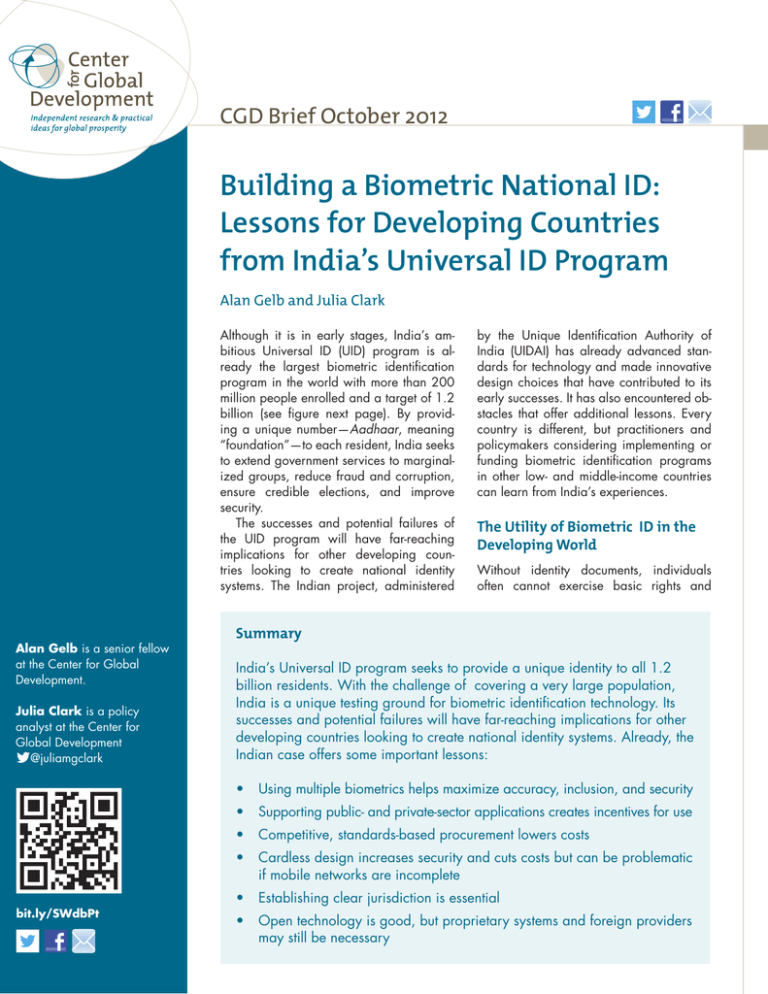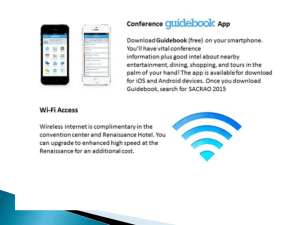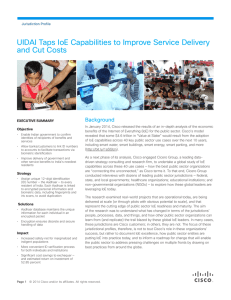Building a Biometric National ID: Lessons for Developing Countries
advertisement

CGD Brief October 2012 Building a Biometric National ID: Lessons for Developing Countries from India’s Universal ID Program Alan Gelb and Julia Clark Although it is in early stages, India’s ambitious Universal ID (UID) program is already the largest biometric identification program in the world with more than 200 million people enrolled and a target of 1.2 billion (see figure next page). By providing a unique number—Aadhaar, meaning “foundation”—to each resident, India seeks to extend government services to marginalized groups, reduce fraud and corruption, ensure credible elections, and improve security. The successes and potential failures of the UID program will have far-reaching implications for other developing countries looking to create national identity systems. The Indian project, administered Alan Gelb is a senior fellow at the Center for Global Development. Julia Clark is a policy analyst at the Center for Global Development @juliamgclark by the Unique Identification Authority of India (UIDAI) has already advanced standards for technology and made innovative design choices that have contributed to its early successes. It has also encountered obstacles that offer additional lessons. Every country is different, but practitioners and policymakers considering implementing or funding biometric identification programs in other low- and middle-income countries can learn from India’s experiences. The Utility of Biometric ID in the Developing World Without identity documents, individuals often cannot exercise basic rights and Summary India’s Universal ID program seeks to provide a unique identity to all 1.2 billion residents. With the challenge of covering a very large population, India is a unique testing ground for biometric identification technology. Its successes and potential failures will have far-reaching implications for other developing countries looking to create national identity systems. Already, the Indian case offers some important lessons: • Using multiple biometrics helps maximize accuracy, inclusion, and security • Supporting public- and private-sector applications creates incentives for use • Competitive, standards-based procurement lowers costs • Cardless design increases security and cuts costs but can be problematic if mobile networks are incomplete bit.ly/SWdbPt • Establishing clear jurisdiction is essential • Open technology is good, but proprietary systems and foreign providers may still be necessary Building a Biometric National ID India’s Universal ID Program by the Numbers 1,200,000,000 Number of Aaadhar numbers when complete 312,000,000 Population of the United States 210,000,000 200,000,000 Population of Germany, France, and the United Kingdom combined Indians with an Aadhaar number as of January 2012 access services necessary for financial and physical security, formal employment, or democratic participation. Governments and donors cannot effectively ensure that funds reach intended beneficiaries. Biometric identification is considerably more accurate and secure than traditional methods of identification and authentication, and it provides an auditable trail of transactions. It offers the possibility of including individuals without documentation, such as the hundreds of millions of poor people who lack birth certificates. When combined with technology such as mobile phones, biometrics can help streamline and facilitate payments and services in remote, underserved locations. India’s UID: Early Successes, Obstacles, and Trade-offs There is no blueprint for an effective, inclusive identification regime. Still, India’s project offers policymakers and donors in other countries the opportunity to take advantage of UIDAI’s successes and avoid certain pitfalls. Using multiple biometrics helps maximize accuracy, inclusion, and security. UIDAI agents collect two iris scans, 10 fingerprints, and a digital photograph from each enrollee. This multimodal system is advantageous for several reasons. First, different biometrics are better at different tasks. For example, iris scans provide more data than fingerprints and are therefore more accurate for de-duplication (ensuring uniqueness), which is critical in a population as large as India’s, but fingerprints are easier and cheaper to authenticate. Second, having multiple measures is more inclusive. Many people (the elderly, manual laborers) have worn fingerprints and some have damaged eyes; using both methods reduces the failure-to-enroll rate to very low levels. Iris scans also allow younger children to enroll because the unique patterns in the eye develop and become stable before fingerprints do. Third, collecting more data upfront allows for the system to expand with population growth, and it is more cost-effective than going back to the field later because the data were insufficient or of poor quality. CGD Brief October 2012 Supporting public- and private-sector applications creates incentives for use. The UID program is designed to be an “identity service provider” for both government programs and the private sector. Users—from pension administrators to banks—can verify people’s identity against their fingerprint and Aadhaar number. When queried, the UID database returns a simple yes or no response to the match; no personal information is provided, but the beneficiaries can prove their identity. Competitive, standards-based procurement lowers costs. The program’s extensive standard-setting programs are designed to provide transparency, accountability, scalability, and technical compliance without proprietary systems that are expensive and limit innovation. This advantage creates opportunities for vendors to compete and bring down costs; it should appeal to international aid programs and other governments. Cardless design has advantages but might not work in all cases. Because Aadhaar authentication is remote, a variety of devices have been developed to verify identity at the point of service. With cellular coverage, a biometric-enabled Bluetooth device (several already exist) can reach rural areas to authenticate ration payments, health insurance, and so on. Cardless operation has advantages. For one, cards are susceptible to hacking, forging, theft, and loss. Online access, however, is not always and everywhere available. It seems likely that most countries, India included, will develop multiple cards for multiple purposes to allow for both offline and online authentication. Establishing clear jurisdiction is essential. The success of the UID program has been hampered by murky constitutional authority. Identifying citizens falls under the jurisdiction of the Ministry of Home Affairs, not UIDAI. The Ministry is concurrently compiling the National Population Register, causing confusion and a turf war between the two agencies. Similar programs should establish clear jurisdiction and coordination across agencies in both budgetary and legal authority. Guidelines Image: flickr user Kevin Labianco. Some rights reserved. Image: flickr user Vince Alongi. Some rights reserved. Alan Gelb is a senior fellow at the Center for Global Development. Julia Clark is a policy analyst at the Center for Global Development @juliamgclark 1800 Massachusetts Ave NW Third Floor Washington DC 20036 202-416-4000 www.cgdev.org This work is made available under the terms of the Creative Commons Attribution-NonCommercial 3.0 license. are needed to delineate the responsibilities of the enrolling agencies and the responsibilities of the agencies providing services, including certification of citizenship. Open technology is good, but proprietary systems and foreign providers may still be necessary. UID contracts out de-duplication to three private non-Indian service providers to draw on the best technology. This may not be essential for a small country where requirements are less stringent, but it suggests the need to carefully consider the roles of national and foreign providers and the relative advantages of proprietary and open-source technology in designing a high-quality system. Conclusions Lack of official identity promotes a cycle of poverty and societal exclusion for many individuals in the developing world. Robust national identification systems are necessary for social, political, and economic development, and they can strengthen aid delivery. India’s UID program is testing a unique model against the challenge of a very large population. It has already provided some important lessons and will offer more in the future, especially as the number of applications using the UID increases. Ultimately, the success of any national ID program—biometric or not—depends more on processes than on technologies. This brief is based on Frances Zelazny, “The Evolution of India’s UID Program: Lessons Learned and Implications for Other Developing Countries,” CGD Policy Paper 008 (Washington: Center for Global Development, 2012), http://www.cgdev.org/content/publications/detail/1426371/. The Center for Global Development is grateful to the UK Department for International Development for support of this work.



